by Zina Hemady
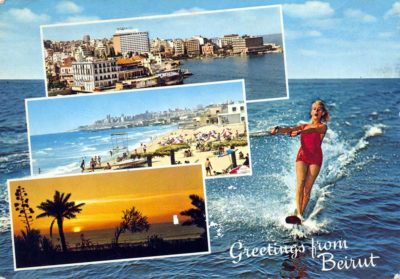
The image of 1960s Lebanon. Norbert Schiller Collection, Phot. Jack P. Dadian
A great deal has been said and written about pre-war Lebanon often described as a carefree paradise where one could ski in the morning and swim in the afternoon. What helped construct this mythical image of the country, besides its natural beauty and Mediterranean appeal, is its seductive capital which rose to prominence during the oil boom years becoming a favorite destination for the jet setting crowd who flew in from all four corners of the world to take part in Beirut’s 1960s to mid-70s gilded age.
For those of us who grew up during that era, we retain fragmented memories of idyllic and romanticized childhoods which would be prematurely aborted as our world succumbed into darkness with the outbreak of the civil war in 1975. In the movies, dark periods hiding uncomfortable truths are usually depicted in black and white to set them apart from the more reassuring present. In Lebanon, always defying every standard, it is the distant past which is remembered in technicolor flashbacks captured in cheerful family snapshots and tourist postcards, while more recent periods are recalled in drab grayscale as those images and memories were replaced by those of bombed out buildings, masked militiamen, and suffering civilians, still haunting most Lebanese almost two decades after the war ended.
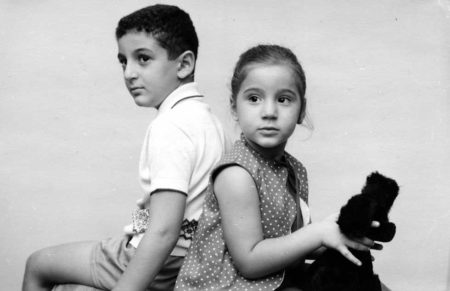
Zina and her brother Ramzi photographed during the Golden Age before they and their peers become known as “Generation War.” Hemady Family Collection, Phot. Roland Sidawy
Born in 1963, I made the tail end of the Baby Boom generation, but my strongest affiliation is with Generation War, a label that describes those who came of age during what the Lebanese call “the events” or the civil war. Therefore, it is impossible for me to think of the pre-war era without some embarrassment and even outrage at our apparent oblivion of the political, social, and religious tensions swelling like a massive underground bubble which would explode and continue to recharge and burst over the course of 15 years shattering our social and national foundations. But for those of us who were barely teenagers then, we had a valid excuse for our disconnect. When I reflect on the people, places, and events of my childhood, they filter through the layers of time emerging in their unaltered technicolor tones as testimonies of a blissful period that I have carefully stored in my heart and thoughts as one of my most precious keepsakes.
Beirut was, and in many ways still is, a small town and my parents had a wide circle of friends. As it was customary to entertain at home, there were regular dinner parties at our Ras Beirut flat during which I used to sneak out of my bedroom to catch a glimpse of the guests, especially the women looking glamorous in their fashionable gowns or mini dresses, depending on the occasion. There were loud conversations and laughter which kept me up, but I didn’t dare complain as it was my choice not to spend the night at my grandparents’. My parents also frequently went out, even on weekdays, and for years after the hotel district had been obliterated by the fighting, they would reminisce about the nights they spent at the Phoenicia hotel’s legendary nightclub, Les Caves du Roy, the nearby Hotel Normandy and Lucullus, a French restaurant famous for its bouillabaisse.
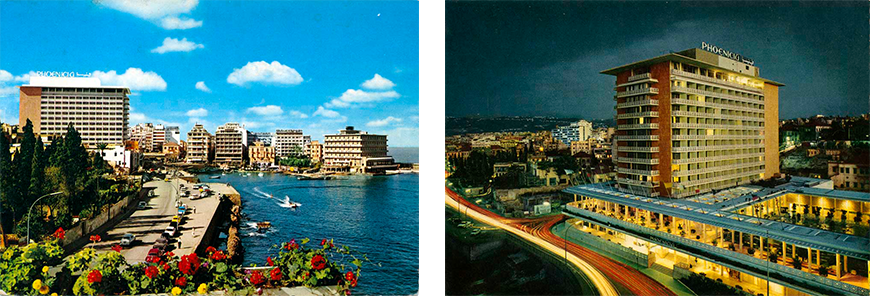
Hotels on the Lebanese Riviera. The Phoenicia Intercontinental hotel by night. Norbert Schiller Collection,Phot. Jack P. Dadian
One of my favorite spots when we ate out as a family was the restaurant at Starco, an office building complex in downtown Beirut which miraculously survived the war. I always ordered “escalope,” but I was never able to finish the huge piece of breaded veal that they served me, and my brother Ramzi ended up with two dinners. The cafés on Hamra Street namely the Horse Shoe, Wimpy, and Café de Paris ranked a very close second on my list to Starco. Hamra, a stone’s throw away from my childhood home, was also a destination for shopping and entertainment. Having acquired a shoe fetish at a young age, I frequently came up with an excuse to walk by the Red Shoe and admire the latest kid styles in their window. Across the street was Zahar, an establishment dating back to the 1930s when it opened its first shop in the old city center’s Souk el Tawileh, where every year my mother outfitted me for the various holidays that my religiously diverse family celebrated. In that same vicinity was my favorite of all, Toyland, where I felt like Dorothy stepping into Oz every time I visited. Last but not least were the iconic movie theaters including Cinema Hamra, Eldorado, and Saroulla where I watched “The Sound of Music” for the first time and developed an obsession with this all-time classic.
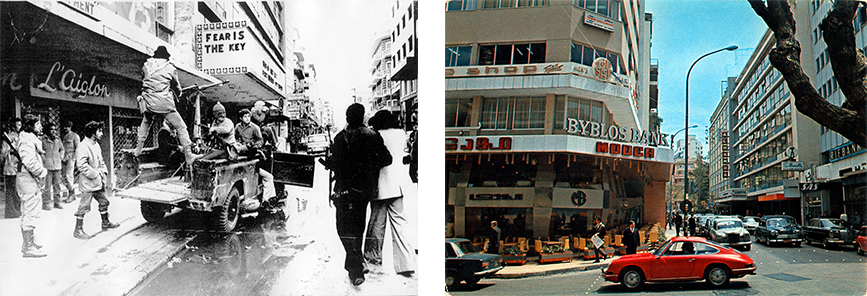
Militiamen on fashionable Hamra Street in December 1975, during the early stages of the civil war. A Porsche on Adel Aziz Street where it intersects with Hamra street during the Golden Age. Norbert Schiller Collection, Phot. (L) Yamani AP, (R) Rifai
The summer vacations were long and we spent a great deal of time at the beach or in the mountains. One of the options was the Long Beach which was, and still is, located along Beirut’s rocky coast and does not offer much of a beach stretch. However, Long Beach compensated for what it lacked with its Olympic and smaller size pools and its bumper car rides. But my favorite by far was Saint Simon, one of a handful of resorts on a sandy stretch in Ouzai, just south of Beirut. There was nothing flashy about this resort with its standard white chalets or bungalows and current-ridden waters, but it was popular among the city’s high flying crowd. My attachment to this place stems from the sense of freedom that it gave me as I frolicked from morning to sunset in the sea and sand with friends away from adult supervision, far more laid back in those days then it is now.

Five-year-old Zina and her family enjoying the summer at their rented bungalow at Saint Simon beach resort south of Beirut. Hemady Family Collection
When the Beirut heat became unbearable, my brother and I spent weeks in my father’s ancestral village of Baakline in the Chouf Mountains with my grandparents. There were dozens of first and second cousins who taught my brother how to shoot a pellet gun and drive my grandfather’s 1950s Ford Mercury, and showed me how to smoke cigarettes in the olive groves and then rub my hands and mouth with the flowers of a fragrant bush to conceal the smell from my suspicious grandmother. In early fall, when the light was softer and the evenings felt crisp, the vines became heavy with white and red grapes which came in many varieties, but the only one I distinctly remember, for obvious reasons, is the “goat’s tits.” My other favorite snacks picked off the tree were the fleshy red figs or their honey-sweet white counterparts.
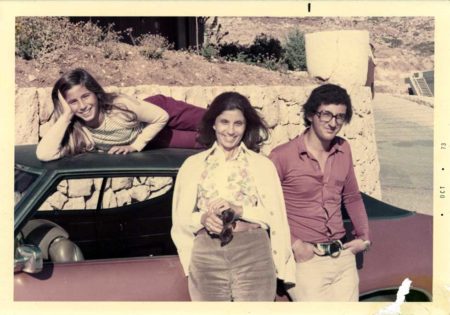
Ten-year-old Zina, her brother Ramzi, and their mother Nuha pictured next to their Pontiac GTO at the Cedars in 1973. Hemady Family Collection
During the school year, we often took trips outside Beirut. Traveling in my father’s burnt-orange Pontiac GTO we drove north along the coast to Jbeil (Byblos) to have lunch at Pepe Abed’s in the city’s ancient port, to Tripoli where we dined at el Shati’ el Fuddi (the Silver Shore), and south to Sour (Tyre) where we stopped at the Resthouse. We also went on picnics to places off the beaten track like Yammouneh in the Hermel region, an area rich in springs and Juniper trees which was rumored to be home to wild horses, although I never saw any. During the festival season we headed to Baalbek, and although I dreaded the long car ride through the Beqaa Valley as my father’s driving was not so kind to my queasy stomach, I am so grateful that my parents insisted on early cultural education. To this day I clearly remember Joan Baez singing to the people sitting in the five dollar seats and Maurice Béjart’s dancers performing “The Firebird” at the temple of Bacchus.

The International Festival of Music and Dramatic Arts at Baalbek. Norbert Schiller Collection, Phot. Manoug
After we started skiing, we spent almost all of our weekends during the snow season at the Faraya ski resort, later moving to the Cedars as it was considered a destination for more serious skiiers. Since we had school half-day on Saturdays at the College Protestant Franҫais, some of my classmates and I claimed sickness to gain additional hours on the slopes, but when we showed up on Monday with a noticeable skier’s tan, we were summoned to the principal’s office.
One by one, the places of my childhood fell to the ravages of war, fading from technicolor to black and white. Saint Simon was taken over by refugees in the aftermath of the 1976 Phalange-led massacre at Karantina; the chalet in the Cedars was occupied and looted by Syrian troops after they entered Lebanon in 1976, and the house in Baakline was bombed during the 1983 Mountain War. These were all material losses which cannot remotely compare to the human tragedies that the war left in its wake, but it is the symbolic representation of these places that I grieve to this day.
I recently had lunch with my cousin Carla at one of the few remaining café trottoir or road-side cafés in re-constructed downtown Beirut. We could barely hear each other over the deafening din of the midday traffic. “Les gens sont epuisés,” she said apologetically explaining that people have been pushed to the deep end after years of political uncertainty, looming economic collapse, and an environmental calamity deep-rooted in governmental corruption. At this point, every Lebanese could use a hint of technicolor in their lives and that is why we cling on to those family albums, frantically collect old postcards, or share posts on social media dedicated to old Beirut as proof of a more insouciant lifetime which was doomed from the start by the tangled web of events that was waiting to unravel.
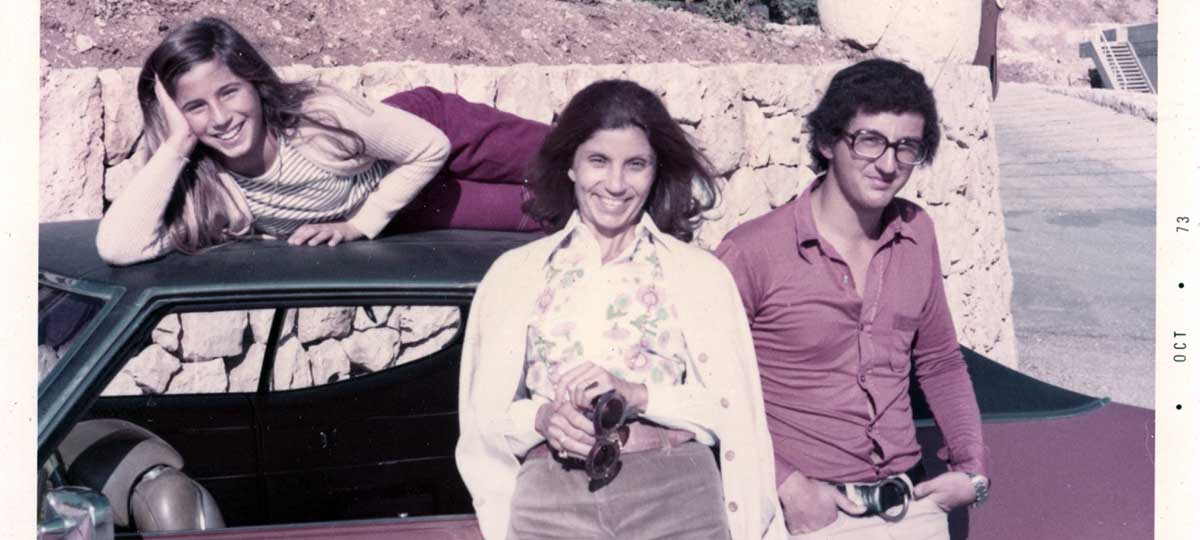
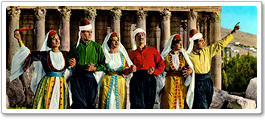
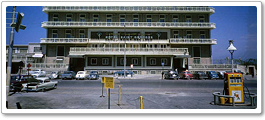
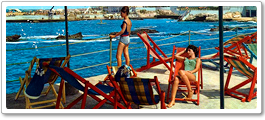

Brilliant
love this Zina, great memories. We used to go to the Starco restaurant as well but our favorite Sunday lunch places were the Bristol Coffee Shop and Popeye.
Wonderful piece of memories we so want to recapture of the country we love. Thank you Zina for your sharing the photos and your prose.
Hoping to see soon Libanon as it was before war
Thank you, Zina. What a great tribute to the “golden age” which I was fortunate to experience in my early childhood. You did a magnificent job capturing the essence of this period. I often look at old photos of family and friends from this period and what a joyous era this was for many of us. The parallels in experience are truly remarkable which is most telling. Mabrouk for this touching tribute.
I will be in Beirut on Wednesday. Somehow it doesn’t seem like these photos anymore.
Amazing how we share these collective memories, and how they are really part of our childhood. While reading this beautiful tribute to our past, it still hurts that those landmarks and that this sweet life vanished. Little did we know what was awaiting us at the corner of 1975.
Loved reading it. It made me vividly relive those years!!!!
I love how you created a lifetime of memories in such a concise yet rich article…. a glimpse that is hard to shatter…. great job Zina!!
It is pretty unique to share all these memories … even the grape “goat’s tits “, My father planted them in our garden in Aley .
Thank you Zina,lovely tribute !
Beautiful tribute to our past. Enjoyed reading it. Thank you for sharing. Ramzi ‘s photo brought back memories of the good time we used to spend on the Basketball court with the guys. Where is he?
You brought tears to my eyes Zina and filled my heart and soul with joy and sorrow. As we Generation War have been trained to navigate between both, with elegance, pride and dignity. Silently. Thank you for this beautiful article ♥️
Thank you Zina for sharing such memorable and heartwarming memories. Hope to rekindle some of those memories when we see you soon. Much love. xoxo ♥️♥️
Zina ya Zina. Beautiful attribute to to our shared childhood years, where have they gone!!
Excellent work Zina and Norbert! This was the image of Lebanon in my student days.
Zina and Norbert you have crafted back into my memory the extraordinary times and beauties of Lebanon!! I so miss it as it used to be and am saddened to experience today’s cloud and shade over a colorful canvas that was. Thank you for sharing your amazing stories and photos!!! Mixed tears of sadness and joy!! Love always xoxo
Thank you Zina and Norbert this article and the curated photographs that are on this website have helped me transform my project. Thank you for helping me by providing the images as well as agreeing to do an interview in which Zina, you answered so clearly.
The website has also helped me as someone who is a part of the young Lebanese diaspora to connect with older Lebanon and the photographs have transported me back to a nicer time in Lebanese history.
Thank you for these beautiful memories .
I’m 71 and still remember these beautiful summers at St-Simon 😢
Thanks for this evocative reminiscense. I also grew up in Beirut — my family moved there in 1963, when I was 8 years old. My years in Beirut were 1963-1970, between the ages of 8 and 15.
We spent our summer days at Plage Saint Simon, coming home with asphalt on the bottoms of our feet (asphalt that my father removed with kerosene). What wonderful days! Of course we were familiar with Long Beach as well, with its rocky coastline and view of the lighthouse.
My schools were Pinewood College, Manor House, College International (Section Francaise), and eventually A.C.S. My sister went to Ahliah Girls School, where Madame Cortas was headmistress. A golden age, for sure.